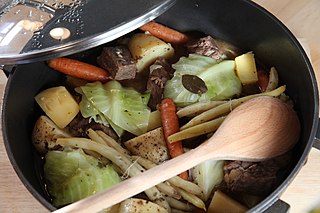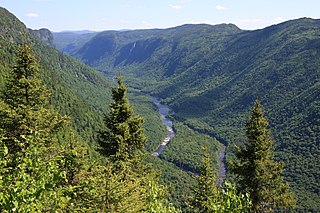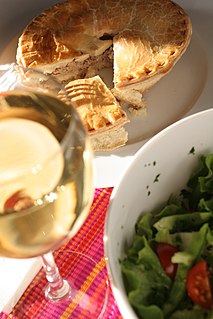
The Saguenay River is a major river of Quebec, Canada. It drains Lac Saint-Jean in the Laurentian Highlands, leaving at Alma and running east; the city of Saguenay is located on the river. It drains into the Saint Lawrence River. Tadoussac, founded as a French colonial trading post in 1600, is located on the northeast bank at this site.

Saguenay is a city in the Saguenay–Lac-Saint-Jean region of Quebec, Canada, on the Saguenay River, about 200 kilometres (120 mi) north of Quebec City by overland route. It is about 126 kilometres (78 mi) upriver and northwest of Tadoussac, located at the confluence with the St. Lawrence River. It was formed in 2002 by merging the cities of Chicoutimi and Jonquière and the town of La Baie. Chicoutimi was founded by French colonists in 1676.

Saguenay–Lac-Saint-Jean is a region in Quebec, Canada. It contains the Saguenay Fjord, the estuary of the Saguenay River, stretching through much of the region. It is also known as Sagamie in French, from the first part of "Saguenay" and the last part of "Piekouagami", the Innu name for Lac Saint-Jean, with the final "e" added to follow the model of other existing region names such as Mauricie, Témiscamie, Jamésie, and Matawinie. The name Saguenay is possibly derived from the Innu word "Saki-nip" which means "where water flows out". With a land area of 98,712.71 km2, the Saguenay–Lac-Saint-Jean is, after the Nord-du-Québec and Côte-Nord regions, the third-largest of Quebec regions in the area.

Québec's cuisine is a national cuisine in the Canadian province of Quebec descended from 16th-century French cuisine. Québec's cuisine began to develop in New France from the labour-intensive nature of colonial life, the seasonality of ingredients and the need to conserve resources. Québec's cuisine has been influenced by the province's history of fur trading and hunting, as well as Québec's winters, soil fertility, teachings from First Nations, British cuisine, American cuisine, historical trade relations and some immigrant cuisines.

La Baie is one of three boroughs in the city of Saguenay, Quebec, Canada. It was created during Quebec's municipal reorganization in 2002. From 1976 to 2001, it was known as the Town of La Baie, a municipality composed of the Grande-Baie, Bagotville and Port-Alfred sectors.

Tourtière is a French Canadian meat pie dish originating from the province of Quebec, usually made with minced pork, veal or beef and potatoes. Wild game is sometimes used. A traditional part of the Christmas réveillon and New Year's Eve meal in Quebec. It is also popular in New Brunswick, and is sold in grocery stores across the rest of Canada all year long.

Lac-aux-Sables is a parish municipality in the Mékinac Regional County Municipality, in administrative district of the Mauricie region of the province of Quebec in Canada. Its population centres are Lac-aux-Sables and Hervey-Jonction.

Pointe-Taillon National Park(Parc national de la Pointe-Taillon) is a national park of Quebec, Canada. It is located on the north shore of Lac Saint-Jean, northwest of Saguenay (city), northwest of Alma, near the village of Saint-Henri-de-Taillon, on the banks of Lac Saint-Jean. The park covers an area of 97.5 km (60.58 mi) has as a 45 km (28 mi) cycling network.

Acadian cuisine is the traditional dishes of the Acadian people. It is primarily seen in the present-day cultural region of Acadia. Acadian cuisine has been influenced by many things throughout its history, mostly the Deportation of the Acadians, proximity to the ocean, the Canadian winter, bad soil fertility, the cuisine of Quebec, American cuisine, and English cuisine.

Réserve faunique des Laurentides, also known by its former name of parc des Laurentides, is a wildlife reserve in Quebec, Canada, located between Quebec City and the Saguenay–Lac-Saint-Jean region. This reserve is part of the network of wildlife reserves of Quebec (Canada) managed by the Ministry of Energy and Natural Resources (Quebec) and the Société des établissements de plein air du Québec. It is located halfway between Saguenay and Quebec.

The lac Otis is a body of water tributary of the southern slope of the Saguenay River via the "ruisseau aux Cailles". It is located in the municipality of Saint-Félix-d'Otis, in the Le Fjord-du-Saguenay Regional County Municipality from the administrative region Saguenay–Lac-Saint-Jean, in the province of Quebec, in Canada.

La Petite Décharge is the name of one of the two emissaries of lac Saint-Jean, the other being the La Grande Décharge. This river flows south of Alma Island, on the northwest shore of St. Lawrence River, in the town of Alma, in the Lac-Saint-Jean-Est Regional County Municipality, in the administrative region of Saguenay-Lac-Saint-Jean, in the Province of Quebec, in Canada.

The Moncouche Rive is a tributary of the east bank of the Métabetchouane River, crossing the Laurentides Wildlife Reserve, flowing in the province from Quebec, to Canada. The course of this river crosses the:

The ruisseau Contourné is a tributary of the north shore of the rivière aux Montagnais, flowing near the northern limit in the Laurentides Wildlife Reserve, in the province from Quebec, to Canada. The course crosses:

Lac Martin-Valin is a freshwater body of the watershed of bras des Canots, located on the north shore of the St. Lawrence River, in the unorganized territory of Mont-Valin, in the Le Fjord-du-Saguenay Regional County Municipality, in the administrative region of the Saguenay-Lac-Saint-Jean, in the province of Quebec, Canada.
The rivière aux Iroquois is a tributary of lac Saint-Jean, flowing the municipality of Sainte-Hedwidge and Saint-Prime, in the Le Domaine-du-Roy Regional County Municipality, in the administrative region of Saguenay–Lac-Saint-Jean, in the province of Quebec, in Canada.
The Rivière à l'Ours is a tributary of the rivière des Aulnaies, flowing on the northwest bank of the Saint Lawrence River, successively in the municipalities of Bégin and Saint-Ambroise, in the Fjord-du-Saguenay, in the region administrative Saguenay–Lac-Saint-Jean, in the Province of Quebec, in Canada.

Tourtière du Lac-Saint-Jean is a Québécois dish of the pie family and a variation of the tourtière dish popular in French Canada. This variant originates from the Saguenay-Lac-Saint-Jean region of Quebec. The tourtière du Lac-Saint-Jean differs from a regular tourtière by having thicker crust, cubes of potatoes, meats and broth, as well as being placed in a much larger and deeper container. Like a regular tourtière, the meat chosen is usually pork, beef or veal. Wild game like moose, hare and ruffed grouse is used if available. Chicken soaked in onions is also sometimes used. Tourtière du Lac-Saint-Jean is prepared for at least 10 servings, which is why it is a popular choice for festivals and "le temps des fêtes". This tourtière also differs from the cipaille of Gaspésie and Acadia because it doesn't use multiple layers of dough and sometimes uses a different set of ingredients. Though, the tourtière du Lac-Saint-Jean is thought to be more closely related to the cipaille than to the regular tourtière. In fact, Saguenay-Lac-Saint-Jean residents typically reserve the name "tourtière" for this specific dish, while referring to regular tourtière as "pâté à la viande".

Fèves au lard, also called bines or haricots au lard, is a traditional Québécois dish. It is usually beans mixed with pieces of bacon and either molasses or maple syrup that is then slow cooked in the oven. Sometimes other ingredients are added. Fèves au lard are usually served as a side during breakfast, but they can also be served as a side during lunch or supper and they can be served as a meal. Fèves au lard is a traditional dish presented at sugar shacks during le temps des sucres in Québec and other French-speaking regions of Canada.
















